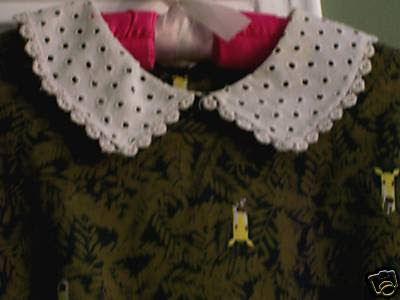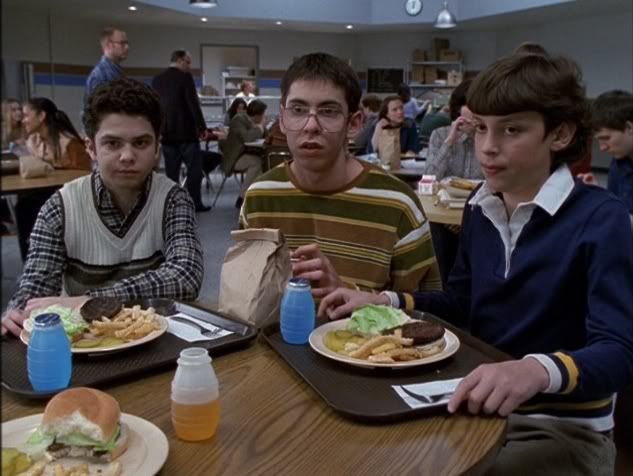
 Excuse the blurriness of the photos. This was a 1950's adolescent girl's dress by "Chubette"- sequestering larger sizes from smaller ones has a rich commercial history. When clothing was made by hand, I imagine there was far less anxiety about size because everything was made to fit the wearer specifically anyway. As you may or may not know, sizes are a big lie foisted upon women to make them feel bad! Anyway, check out those deer heads hiding in the trees! I think I didn't buy this one because I forgot it had this print and I was like, "Why am I watching this?"
Excuse the blurriness of the photos. This was a 1950's adolescent girl's dress by "Chubette"- sequestering larger sizes from smaller ones has a rich commercial history. When clothing was made by hand, I imagine there was far less anxiety about size because everything was made to fit the wearer specifically anyway. As you may or may not know, sizes are a big lie foisted upon women to make them feel bad! Anyway, check out those deer heads hiding in the trees! I think I didn't buy this one because I forgot it had this print and I was like, "Why am I watching this?"PS: "Chubette" is a good name for a band. Especially a Roxette cover band made up of people who are fat! This idea is free of charge and just waiting to be taken, ladies.

i am anxiously awaiting the creation of a roxette cover band by awesome fat people.
ReplyDeletethat reminds me, have you heard of "sheezer?" an all-girl weezer cover band made up of amazing badass musicians. look it up if you haven't already heard of them!
Sizes are a big lie foisted on [women] to make them feel bad? Who is doing the foisting? I've worked in manufacturing for close to 30 years and I can honestly say that this has *never* entered my mind. You know, sizing numbers used to mean something. They represented "scale", an archaic system of ratio and derivations (aka aliquot parts) represented on a pattern maker's drafting scale. The meaning and designation of size numbers were wrested from manufacturers as organized retail entities gained prominence (post WW2). Manufacturers went along with it because it made sense in determining allocation and the distribution and commensurate quantities of each (long story but it's on my site). The short and long of it is sizing is evolutionary; it adapts and adjusts to the mean. Altho we use numbers to designate sizing, it represents a social construct, not a scientific one.
ReplyDeleteI agree that sizing is a social construct, and I was not aware of what the older larger number sizes were based on-very interesting. I wasn't talking about vanity sizing, though.
ReplyDeleteMy point is that sizes for women are much more socially constructed than sizes for men; men's sizes (usually) literally go by actual measurements and women's sizes go by a number which is often arbitrary and fluctuates wildly from brand to brand, and even within a brand (H&M, for instance, has almost zero consistency within their brand.)
Consequently, women feel bad because they identify, or want to, with a certain size, even though the size isn't consistent. Ideally, women's sizes would be based much more upon the actual measurements they are intended to fit, instead of a number like "6" which often means very little. I have worked in used clothing stores for years, and people always say, "Oh, a 4! I'll never fit!" even though the size 4 will be larger than the size 8 in their hand.
Why can't women's clothing sizes be more like shoe sizing? I look in people's closets and they have extra-small garments through larges and zeros through sixes but it's not like you have some size 8 shoes and size 5 shoes that both fit.
More ideally, people should be able to eyeball something and analyze whether it will fit because they should know what will fit them. People rely too much on size, and too many women feel anxiety over their sizes. They should serve a more ultilitarian purpose- which men's clothing and sizing has always had.
I realize you weren't talking about vanity sizing but it is all connected. You're mostly talking about sizing and fit evolution and sizing to the mean which is in that series.
ReplyDeleteMen's sizing will always be different because... well, I can't paste the link. It's disabled for me in your template. Ditto on the link for shoes. Altho the size and shape btwn people's feet differs, it is largely a predictable variation. Not so with people's -mostly women- body shapes. Again I'd post the link but I can't but it's in my vanity sizing series. It's some work to read it all but I can't drill it down. If it were easy to explain, people wouldn't have these continuing questions and the market would be in less disarray.
But that sounds like I could be blaming the customer or foisting the responsibility onto them. I am not a popular person. I'm on your side. I work in the industry trying to change things like this. Things aren't getting better. They're getting worse. And they will continue to get worse. Consumers do have some means to change things but first they need to know they do and how to do it. Fragmentation is the problem on both sides.
It's not something you sit down and decide that you and some friends are going to start protesting. It just seems like a waste of time to have to do that with so many other priorities. You shouldn't have to do that -which is yet another reason consumers are resentful toward the industry.
I do wish things would change. I love what I do. And I love to make nice clothes. But nobody wants it anymore. Not enough people want to pay for it now -and besides, the economy is in the toilet.
Summary: read the series if you're of a mind too. I can't drill it down as much as I want to. Yes I went on at length but I did work on a draft of a new entry in my series based on some ideas in this thread so maybe I'm pre-testing new concepts and material.
Hello Mary. I've commented on 'Rip It To Shreds' a few times, and I JUST discovered this blog today.
ReplyDeleteBut the absolutely glorious benefit of shopping tiny thrift stores is that you learn to ignore whatever the tag says, look at something and say, "Yep, that'll fit me." It's something I'm very proud to have developed over my life.
Hope you're well.
Thanks for reading! Or looking, in the case of this blog.
ReplyDelete